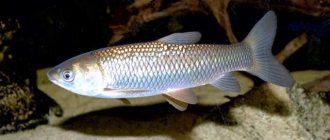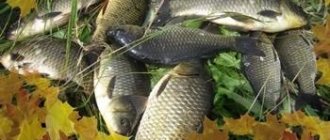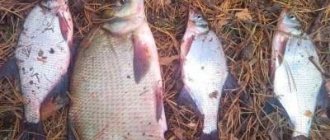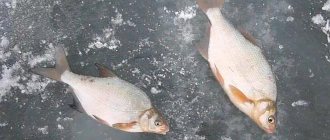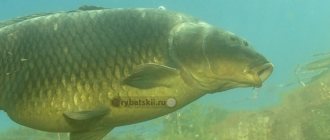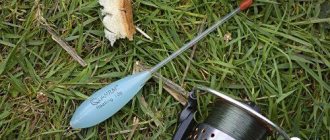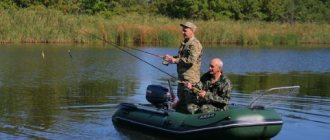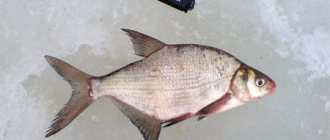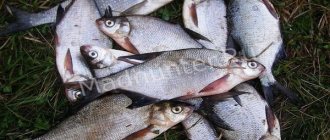Fishing for bream on a feeder in spring and summer on the river
When planning to catch bream with a feeder, you need to imagine the behavior of this fish in the reservoir of your choice: parking places, biting times, taste preferences of bream in a particular season of the year.
Most often, it is the bream that first begins to bite in reservoirs, as soon as the ice melts. This fish adapts most quickly to new conditions. And you can catch bream throughout the open water season until the very first ice.
The time for catching bream can only be discussed in relation to a specific body of water and taking into account weather conditions. No more weather-dependent fish! Only large crucian carp pays more attention to weather changes. And bream can even leave their usual place, fed for months, only because the atmospheric pressure has increased or the water level has risen slightly, or the degree of its transparency has changed.
Read also: Fishing calendar by seasons and months of the year
Therefore, catching bream, in general, and catching this fish using feeder equipment is an equation with many unknowns, each of which can affect the final result of fishing.
Where to catch bream
In the river, any peaceful fish (including bream) of medium and large size prefers to move along the channel edges, carefully examines dumps, entrances and exits to pits, places with slow or reverse flow, underwater large stones, as well as any places of shelter. In places where it is possible to find food, schools of bream appear at least once a day.
Milkers and floaters find such places and patiently wait for fish to emerge. Feeders have an advantage over other fishing methods. It lies in the fact that the angler can lure bream to the fishing spot and keep it in this place for quite a long time.
Fishing for bream with a feeder in reservoirs with a current is more effective. Because the current carries the bait down, informs the fish about the presence of food and lures the fish. In calm water bodies, feeder bait attracts the attention of fish in a limited area of the bottom.
When to fish: biting calendar by fishing season
The bream bites most actively in the spring, in May. Location near edges, seaweed, shell banks, holes, river beds. It is better to fish in calm, windless weather.
The fish can be frightened by even slight fluctuations in the water. In the spring, you need to look for a place where fish feed and to collect them in a heap, it is advisable to immediately feed this place with bloodworms. In strong currents, you can add crackers, bran, and milk powder. In the absence of bloodworms, pearl barley, rolled oats, and chopped worms are suitable.
As the summer season ends, the fish begin to feed intensively and by autumn they move further from the shores to quiet waters, closer to the muddy bottom.
Finding her becomes more difficult. The catches are better in the morning, while the fish are in shallow water. Closer to noon, the bream goes to the depths.
It is good to fish from the shore using a float or bottom fishing rod. It is advisable to use large hooks.
But in autumn there are more bites from the boat. An echo sounder helps you find schools of bream. At this time, the fish go to certain places to feed.
You need to choose one place for complementary feeding. Balls of porridge and dough should be quite dense, without adding any odorous substances. You can only add a pinch.
In the fall, the bream goes for worms and bloodworms, but after a couple of bites, it can cast the bait and swim away. After some time, return to the same place again. The main thing is that when he returns, the bait lies on the bottom intact and intact.
During the winter season, fish migrate. Her route is unpredictable. Often she simply swims through fishing spots. The food should be placed into the holes made frequently, 1-2 times every 3 hours, maintaining a distance of 4-5 meters between the holes.
Feeding for breams in winter is usually in the morning (at 10 o'clock), and on the edge - closer to lunch. Somewhere in January you simply cannot do without bait. Fishermen feed up to 15-20 holes at one time.
Choosing a good place, feeding in a timely manner, choosing suitable gear - this is the success of winter fishing and, of course, without much experience it is quite difficult to foresee all this. Fishing will require strength, and most importantly, patience; when catching bream, it is simply necessary.
Choosing a place to catch bream
You should start searching for a suitable place by studying the bottom. On reservoirs without a current, you can use a standard (purchased) or homemade depth gauge to measure depths. If possible, you can explore an interesting area of the reservoir using electronic devices.
In reservoirs with a current, the exact depths are more difficult to determine, but you can study the bottom topography using the techniques used in spinning fishing. To do this, it is enough to conduct the load several times evenly or stepwise. The tension of the fishing line and the impact of the weight on the bottom can tell an attentive fisherman about the nature of the bottom, about the drops and rises.
Read also: Echo sounders for fishing. Which to choose?
In order to identify all interesting bream sites from the point of view of potential sites, you will need:
- feeder rod equipped with a reel with fishing line wound on a spool,
- the load is sufficient so that it is not carried away by the current;
- an alcohol marker that allows you to leave marks on the fishing line.
Usually on the river, anglers choose a distant channel dump to cast feeder equipment. And on reservoirs without a current there are pits or tables. Any changes in the bottom topography are of interest to bream.
Habitat
Bream lives in almost all water bodies of the CIS countries. Its presence was also noticed among fishermen in the Aral and Caspian Seas. The individual is a fairly common individual; a place for capture can be found in any nook of a reservoir. Favorite habitats are where the waters are calm and there is a lot of shell rock. In areas of mountain rivers, it is useless to look for this specimen; the rocky bottom and stormy conditions are not for bream, since the fish loves moderate water elements, where there are quiet, deep places with a reverse whirlpool and a slight current. Unacceptable places and with cold water, the fish avoids such waters. It is better to fish in places where the bed of a river or flowing lake consists of a sandy-clayey or silty bottom with shell rock.
The individual feeds on both algae and its diet includes mollusks. Also don't mind trying crustaceans. There have been cases when a fish pulled a crayfish out of a hole at a time when the crayfish's shell was at the molting stage. It is worth noting the fact that the fish is quite smart in its own way, so it is quite timid.
Read: How to cook pasta for bream fishing
There have been cases among experienced fishermen when, during the catch, when the bream was spawning, they had to talk in a whisper! Otherwise, the fish changed their locations. From this it is concluded that it is necessary to fish in silence and not stir up the water, creating a huge amount of splashes.
You can’t name a specific location for bream; everything depends on the time of year. In hot weather or severe frost, schools of bream stay closer to the shore, as there is more food there. From this it is worth drawing a conclusion; You can catch an individual using bottom tackle or a float rod. It is worth noting that the bite of bream on a float is very careful and almost invisible. Therefore, you should pay close attention to the bite, otherwise you may not hook it, and the fish will spit out the bait. If hooked, the bream usually does not resist; at the beginning of fishing, it hangs on the hook like a “log”; even an experienced fisherman may not feel that the trophy is already sitting.
It’s worth choosing almost any time of day to catch bream. But there is one point, if this is the day, you need to look for bream at depth in holes, slopes, and edges. And at night -
Near the shore and in shallow areas of rivers and reservoirs.
It’s good when you have information about the bottom topography, or have studied it using an echo sounder. Places of holes and drops, which are connected by several small areas. This is an ideal place for feeder fishing and is ideal for a bait table. In order to feed the bream.
Feeder equipment for bream
Feeder fishing always requires thoroughness. The fishing area must be equipped. You will need a flat surface for a fishing chair or high chair.
You need several rod stands - at least 2 pieces. When fishing for bream, especially if bites from large fish are possible, a landing net is vital for the fisherman.
Naturally, the fisherman must be dressed for the weather.
Feeder rod
Equipment for bream is standard equipment for a feeder rod.
It is best to choose a fishing rod made of carbon fiber (carbon) with a tip test of 80-120 g. This test is explained by fishing in the current, because bream is a deep-sea river fish. You will have to make long casts to successfully catch large specimens.
More experienced anglers should use a “fast” action blank. Beginners should pay attention to the “medium” and “slow” tuning. This is explained by the technique of throwing large feeders over a long distance.
When fishing for bream on a feeder on a river in spring or summer, the length of the rod should be at least 3 meters. The optimal rod length is considered to be 3.3-3.6 meters.
So, let’s summarize which blank rod to use when fishing for bream with a feeder on the river in summer or spring:
- Length - 3.3 meters;
- The action of the rod is fast;
- Rod test - Heavy Feeder “Heavy” up to 150 grams;
- Replacement tip test - (for fishing conditions: current strength, casting distance - feeder weight) - from 60 to 120 grams.
Feeder reel
The reel is usually used inertia-free, equipped with at least five metal bearings.
The reel spool can be straight or tapered. If you have to cast gear over long distances, then it is better to choose a spool with low sides.
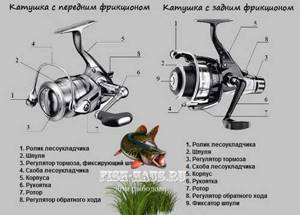
Reel for fishing with a bream feeder:
- Inertialess;
- Coil size from 3000 to 4000;
- The mass of such a coil will be approximately 400 grams;
- The rear clutch is more convenient;
- Gear ratio 4.5:1 or 5:1. The gear ratio of the feeder reel number 5 indicates that the line layer will make 5 revolutions (skeins per spool) with one revolution of the handle. Such reels have proven themselves on the positive side in terms of quality and suitability for feeder fishing.
When catching large bream, a baitrunner is a good idea. When the baitrunner is turned on, the fish will unwind the line from the spool under tension, which will prevent it from getting off and dragging the rod into the water.
Line or cord
The spool can be wound with a monofilament line made of polymer materials or braided line. The thickness of the fishing line must correspond to the fishing conditions.
On the river, it is more advisable to use braided fishing line to reduce its windage in the water. The optimal diameter of the main line can be considered 0.18. This diameter has a breaking load of at least 12 kg, which is more than enough. Many bream feeders use a shock leader to reduce cord friction under high loads when casting bait with a feeder. The length of the shock leader is 2 times the length of the rod being used.
Read also: How to tie fishing line with braid

Feeder feeder
Feeder feeders in feeder fishing are consumable material, like hooks. There should be several types of them in stock (various weights, shapes, volumes). For the middle course of the river, using the gear described above, the initial weight of the feeder can be considered 40-60 g, optimal 60-90 g.
Leash
It is better to make a leash from monofilament, at least 50 cm long, with a cross-section of at least 0.16 mm.
The cross-section of the leash can only be reduced in crystal clear water, but this will increase the possibility of a break and a fish coming off.
Hook
The hook must match the size, color, and bend of the main bait and the size of the fish that you plan to catch.
Athletes are advised to use smaller hooks when catching bream on a feeder in the summer on the river. A small hook is easier to disguise with bait and the bream is more likely to swallow it and get hooked. Often small things constantly get caught on a small hook and bait; if you increase its size and bait, then the small things will bother you less, but bites from large fish also become more careful and rare.
At the same time, a small hook can simply fly out of the mouth of a large fish when hooking, especially if the bait is tight, even with the sting open. This is why many amateur fishermen prefer to use a larger “normal” hook, even at the expense of its concealability. Others, on the contrary, do not see the dependence of the size of the hook on the size of the fish.
In general, we can give the following recommendations for selecting a hook for bream when fishing on a feeder:
- If bloodworms are used as a bait for bream, then the optimal size will be No. 16-14;
- Maggots can be attached one at a time or several at a time; it is better to choose a hook for catching bream No. 14-10;
- For corn, pearl barley, mastyrka, hominy, you can take medium sizes: No. 14-8;
- For the worm, you can choose a medium or long forend with No. 10-6.
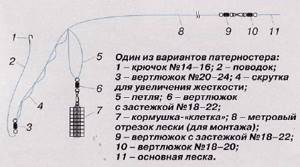
Installing feeder equipment on bream
Some fishermen mount the equipment directly on the main line, making knots and limiting the movement of the feeder with a stopper. Other feeder hobbyists make ready-made elements at home, using different thicknesses of fishing line and making several types of rigs. Crimping tubes can be used instead of knots.
A lot has been written about feeder equipment. We advise you to read about the types of feeder rigs here and about the feeder rig for catching bream on the river and the Gardner Paternoster Reservoir.
Watch the video of feeder rigs for catching bream on the river in summer - the best feeder rigs:
Winter tackle for bream
Catching bream in winter with a fishing rod
For fishing in the current, you can use different types of fishing rods and equip them differently. Some anglers prefer to fish with a “filly” with a float rig, others prefer to fish with a fishing rod equipped with a reel and a nod. However, you can do the opposite - equip the “filly” with a nod, and the reel fishing rod with elements of a float rod. What will be located at the bottom, a jig or a leash with a hook, is also a matter of taste. We prefer to use an end sinker and a 5-10 cm long (20 to 50 cm) leash with one or two hooks standing above it. If we use jigs, then only small ones, which are placed one after another on a leash with an interval of 5–7 cm.
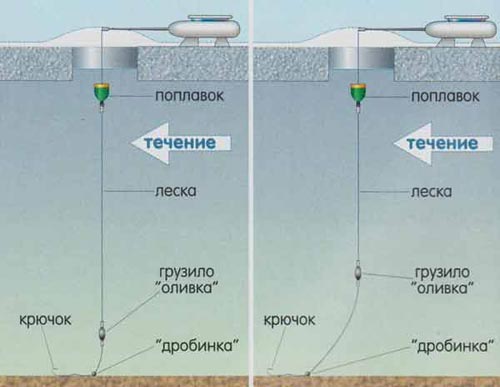
Read also: Catching bream with a reelless bait
A good nod made from a clock spring is a good bite alarm. The sensitivity of such a nod, depending on the strength of the current, is easily adjusted by its length, whereas in a strong flow the carrying capacity of a conventional float may not be enough, and it will go under the ice. If parts of the nod equipment - throughput cambrics or rings - freeze in the cold, you should first rub them with wax.
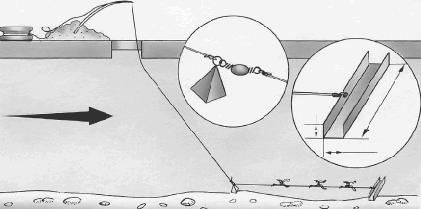
Read also: All about helicopter fishing in winter
To connect the main line and the leash, it is advisable to use a snap hook and a swivel. It would not be amiss to install a swivel at the connection with the sinker, the weight of which can vary between 10–50 g.
Fishing line for bream in winter when fishing in the current
When fishing, the bream actively resists, so the main fishing line is taken with a diameter of 0.16-0.18 mm. Naturally, it must be of very good quality. The leash is placed with a diameter of 0.11-0.13 mm. Tackle made from a fishing line with a smaller diameter, exposed to the additional influence of the current, may break. It is better to take small hooks: with a normal shank and a straight bend, No. 15–18 for bloodworms and No. 12–15 with a long shank for a worm.
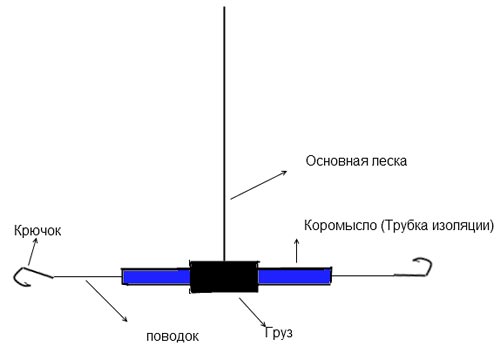
You can also use equipment based on a sinker made in the shape of an olive. In this case, one leash is placed behind the olive, and the other in front of it. At the same time, the use of different baits, for example a worm and a bloodworm, allows you to determine which one is more catchy. Here it should be said that long leashes are good only when fishing is carried out in a strong current with a sinker fixed at the end of the line; only then does the leash move widely from side to side, attracting fish.
This is interesting: Fishing with a garland in winter
Bait for catching bream on a feeder
Nowadays, it is not so difficult to buy bait mixtures labeled “feeder” or “bream” in the store.
The difficulty is that the seller can offer several types of such baits, with different properties. In addition to bait, the seller will definitely offer a flavoring agent. When catching bream on a feeder in the spring or summer, it is best, of course, to make a small supply of bait by purchasing several bags of a commercial mixture with different properties and select a suitable one on the pond or even create a mixture of several baits. Sometimes this works great on unfamiliar bodies of water.
Read also: The best bait for bream with your own hands
You need to be careful with flavorings. In cold water, fragrances can repel fish. In summer it's a different matter. In late spring and summer, bream favors aromas such as bloodworm, dill, garlic, vanilla and anise. You can try “sweet flavors”: caramel, strawberry, banana...
Their use can also attract carp, carp, and barbel.
The following can be used as bait filler for bream:
- millet,
- barley,
- wheat,
- corn and peas.
The main requirement for feeder bait is that it must be completely washed out of the feeder. Therefore, it cannot be over-moistened at the time of mixing.
For kneading, a container is used - a plastic or folding cloth bucket and a mixer.
Bream fishing tactics in winter
In winter, schools of bream live mainly in the depths - in large wintering pits, on their slopes and edges. Very often in reservoirs, bream stands on flat plateaus bordering the river bed.
In an unfamiliar body of water, the depths, and therefore the expected locations of bream, can be found out either using an echo sounder or by asking local fishermen who know this body of water. Very often, bream pits can be identified by a cluster of motionless anglers sitting at a sufficient distance from the shore.
Once the fishing location has been determined, they begin drilling holes. When drilling holes, you should not forget about fishing ethics - do not drill closer than 10-15 meters from your neighbor’s holes, do not walk on the ice near other fishermen without unnecessary need, annoying people busy with what they love with inappropriate and unnecessary questions.
After the holes are drilled, they are baited using a dump feeder, wait a while (about 30 minutes for the bait to attract fish) and begin fishing.
When fishing with a float rod, 2-3 baited tackles are placed in the angler’s line of sight.
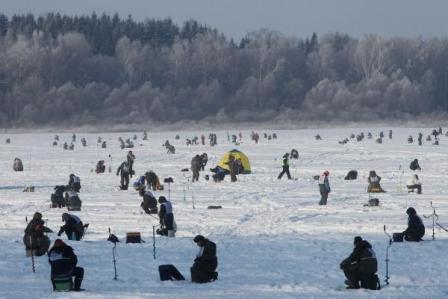
From time to time the tackle “moves”, lifting the bait from the bottom by 2-5 cm, makes several jig-like oscillatory movements and lowers it to the bottom again.
They can catch it with a jig using both active play and a stand-up position. When fishing on a stand-up line, the baited jig, as when fishing on a float rod, is periodically “moved.” Game fishing is an active activity in which an angler fishes up to several dozen holes in a day in search of bream. Bream in winter is very passive most of the time, so the action of the jig should be smooth and slow, with short 2-3 second pauses. When catching bream, a technique such as “knock on the bottom” also showed itself well - the jig is raised and lowered to the bottom several times, which leads to the formation of a cloud of turbidity at the place where the bait falls, attracting fish.
Bait for bream
Bream is an almost omnivorous fish. In spring and autumn, it is better to equip the feeder tackle with bait - bait of animal origin. Bloodworms, maggots and red worms are rightfully considered the most popular.
In summer, baits that bream favorably regard include insect larvae, as well as baits of plant or artificial origin.
Vegetable baits for summer bream include seeds of grain and legumes. Lures of artificial origin are silicone bloodworms, crustaceans, as well as foam balls, which recently for some reason regularly interest not only bream, but also other large fish.
Do you want to catch a large bream on a feeder on a river in spring or summer! Fish House will share advice on what to use to catch bream on a feeder on the river. As everyone knows, bream, especially large ones, love large baits and lures. Any fish is also guided by aroma.
So, let's begin?!:
- choose hook No. 14;
- we thread one light maggot by the skin to the forend;
- Let's take garlic! thread a boilie (the size of a pea or in the form of a small tablet) (it is already on a thread, sold in packs of 30 pieces) until the maggot;
- put the second maggot on the hook;
- and finally a beautiful live worm.
This attachment helps out even in slow times. It is worth remembering that large bream bite well either after sunset or before 1 o’clock. Or from 3-4 o'clock to 7-9 o'clock.
Strategy for catching bream on a feeder
Having figured out the casting point, you need to thoroughly feed the place. To do this, a high-capacity feeder is mounted on the feeder. Using this feeder, at least 10 portions of bait are sent to the feeding point.
If you are sure that a large bream will immediately be suitable for bait, then you can immediately add large fractions (corn, steamed wheat, peas) to the bait. If you are not so sure, you need to attract small fish to the fishing spot first. We add small fractions that create turbidity to the bait (millet, breadcrumbs, yogurt, semolina).
Only by creating a small but compact bait spot can you mount a “working” feeder, which you will equip with a bait mixture. The bait (or bait) is placed on the hook
Next, you need to cast to the baited area. Waiting for a bite – no more than 10 minutes. Then, regardless of the result, the tackle must be worn out, the feeder must be equipped with a new portion of the mixture and sent back to the feeding place.
Sooner or later, the bait carried downstream will attract the fish to the bait. From the moment of the first bite you need to be extremely careful. Following the small fish, after a while large fish approach the bait. The first sign is that the bites of small fish suddenly stop.
The tackle needs to be pulled out, large fractions added to the bait, and larger bait placed. You need to cast the tackle again, loosen the reel clutch in advance and wait for a bite from medium and large bream.
Biting bream and catching it
The bite of a large bream on the feeder is reliable and confident. The top either sharply straightens, or just as sharply straightens.
The hook must be sharp. The fight even begins. Large bream do not give up without a fight. He tries to go to the center of the fairway, turn his body across the current and, using its strength, go as far downstream as possible.
You need to try to stop it with the movement of the rod. The friction clutch will allow the line to be pulled in jerks. Sooner or later the bream will get tired. It can be pulled closer to the shore.
You can only take bream in a landing net. Moreover, you need to act carefully. Even a weakened bream at the sight of a landing net can decide to make a “last push”, breaking off the leash with the hook.
Fishing for large bream should never be forced. The afterburner will not save time when fishing, but it will increase the chances of a break. And fighting close to the bait spot can scare away the fish standing there.
Take your time, and you will catch bream.
Catching bream on a feeder in spring and summer video
Fishing for bream on the river video
Catching bream and bream on a feeder on a river with the current video
TV channel "Hunting and Fishing"
Excellent morning bream bite
Bream on the feeder. Video report about fishing on the southern dam of the Gulf of Finland in St. Petersburg. The bream was actively biting on the feeder; the bream was especially active in the early morning, before 8 o’clock. After an unsuccessful trip, I finally decided to give revenge to the southern bamba. This time the weather was just great and the bream were biting constantly. I used maggot + worm as bait; I added chopped worm, maggot and boiled peas to the bait as additional components. I tested the Running Feeder Rig, a new rig for myself, on beaded rubber, I was very pleased with it, I will definitely be fishing with it in the near future.
Time to bite?
Knowledgeable people believe that there is no difference in time. It bites both in the morning and in the evening. The difference lies in the preparation of the bait. For example, during the daytime the diet includes dough or mastyrka, barley groats. At night or in the evening, maggots and a traditional red worm are suitable. This sandwich can also be used during the day.
It is worth noting that at night the bream prefers only this attachment, so as not to waste time, you should listen to the advice. Although it is possible to conduct an experiment!
The time of year to start catching bream is considered to be March, April, May in these months, depending on the region, when bream is most active.
In those regions where there is still ice on rivers and reservoirs, active biting may occur a little later. Bream begins to actively feed immediately after the ice melts and looks for food near the shore, preferring any bait.
During spawning at the height of spawning, bream becomes unpretentious to food. Therefore, it will become increasingly difficult to catch him. Almost until the very beginning of the warm July days of summer.
But after the spawning period, activity picks up again, and the fish come out and actively feed. In addition, he begins to approach the shore less often than in the spring.
Read: Catching bream and roach from the surface
During the cold period of late autumn, it is almost impossible to catch bream. Schools of fish go to depth and become motionless until winter. Hence the conclusion is that any fishing gear will not be effective.
Fishing in summer is not as active as during spawning. Bream does not bite very well in the heat, like some other fish; White amur. However, this does not mean that bream cannot be caught. If you know its exact location on a reservoir, selecting the right bait ration while experimenting, experts successfully catch it in the summer.
It is worth noting that the most optimal period for bream fishing is the end of August. At this time, the active bite begins again, this is explained by the fact that the fish must build up its fat reserves for the winter. Then it goes deeper for the winter.
